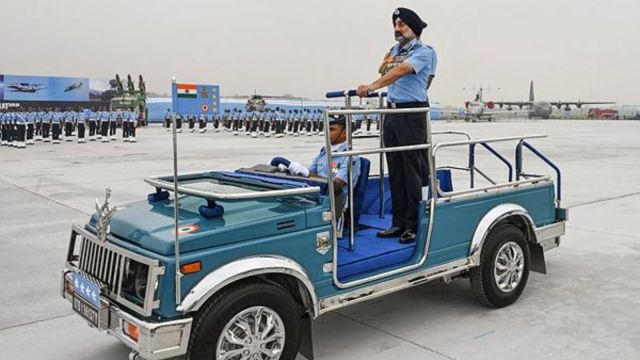Operation Sindoor restored rightful place of offensive air action in national consciousness: IAF chief
The air chief marshal was addressing air warriors on the occasion of the 93rd Air Force Day at the Hindon air base.
 Chief of Air Staff, Air Chief Marshal Amar Preet Singh, inspects the parade on the occasion of 93rd Air Force Day at Hindon Air Force Station, in Ghaziabad on Wednesday. (ANI photo)
Chief of Air Staff, Air Chief Marshal Amar Preet Singh, inspects the parade on the occasion of 93rd Air Force Day at Hindon Air Force Station, in Ghaziabad on Wednesday. (ANI photo)The Indian Air Force’s execution of Operation Sindoor has proved to the world how air power can be effectively used in shaping military outcomes in just a few days, Chief of the Air Staff Air Chief Marshal A P Singh said on Wednesday.
Singh said his force’s “bold and precise” attacks on enemy targets during the operation restored the rightful place of offensive air action in the national consciousness.
The air chief marshal was addressing air warriors on the occasion of the 93rd Air Force Day at the Hindon air base.
Singh also awarded citations to a number of Indian Air Force (IAF) units, including a Rafale squadron, for their stellar performances during the operation.
Hailing the success of Operation Sindoor, Singh called upon the air warriors to “remain prepared” for future security challenges, emphasising that the IAF’s planning must be “innovative, practical and adaptive”, and its training must be based on the principle of “train like we fight”.
“Our performance in Operation Sindoor fills us with professional pride. We proved to the world how air power can be effectively used in shaping military outcomes in just a few days,” he said.
The Chief of Air Staff described Operation Sindoor as a shining example of what can be achieved through “meticulous planning, disciplined training and determined execution”. He said, “India’s bold and precise attacks restored the rightful place of offensive air action in the national consciousness.”
He said, “Our robust air-defence architecture and offensive employment of long-range surface-to-air missile systems limited the adversary’s ability to operate and ensured the safety of our vital assets.”
Hailing the “outstanding performance of the indigenously-developed and integrated weapons, which delivered precise and devastating blows deep inside enemy territory,” he said it vindicates “our faith in home-grown capabilities.”
Last week, Singh said at least a dozen Pakistani military aircraft, including US-origin F-16 jets and Chinese-origin JF-17s, were destroyed or damaged in Indian strikes during Operation Sindoor.
In his remarks, the air chief marshal also noted that the increasing pace of integration of new systems, weapons and equipment into the IAF’s operational plans has been a “significant success”.
“I can see that there is an increased culture of accountability, safety and security amongst the air warriors and this is directly reflecting in our reduced incidents and accidents,” he said.
“At all levels, leaders are leading from the front, demonstrating exceptional vision and empathy. They are ensuring that every individual is empowered with the necessary training and is motivated,” he added.
The Chief of Air Staff also underlined the need for the IAF to remain prepared for any contingencies and called for “effective teamwork”.
The air chief marshal also called for the IAF to leverage its “collective strength” and “foster synergy” not only within the force but also with other defence services.
In addition, the Chief of Air Staff referred to his force’s role during various national crises. “During Operation Sindhu, the IAF sprang into action to evacuate Indian citizens from conflict-ridden zones,” he said.
New Delhi launched Operation Sindhu in June to evacuate Indian nationals from conflict zones in Iran and Israel.







